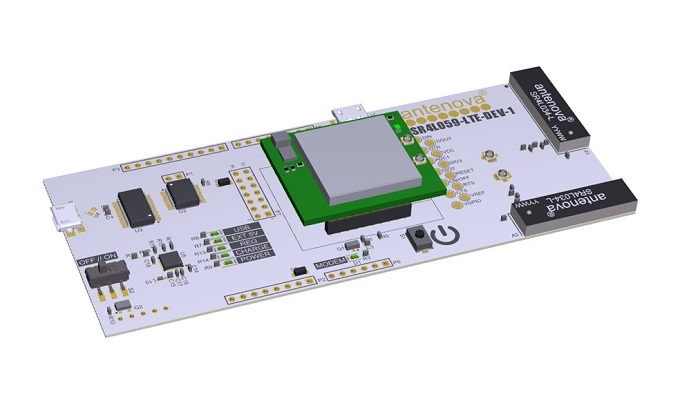By Alex Pluemer, contributing writer
Antenova Ltd. recently unveiled a variety of new antenna products, including blade and positioning antennas, and a new development kit for Cat4/LTE designs.
Here’s the new lineup:
- The new Magna antenna (part# SR4I051) is only 1.6 mm thick and operates in the ISM frequencies at 868/915 MHz. Designed for use in industrial IoT and smart building applications, the Magna is supplied with a cable and an IPEX connector and features an adhesive underside to firmly affix it inside a device. The Magna is a new version of Antenova’s REFLECTOR antenna and is designed to operate on or near metal surfaces by integrating two isolated electrical layers, enabling it to radiate on a metal surface or housing. Antenova said that the Magna antenna works over longer distances than can be achieved at 868/915 MHz so that it can be used outdoors or in large warehouses, and it operates on metal lighting and ceiling fittings.
- Antenova’s new blade antenna (part# SR4G055) and reference design is intended for small, high-performance on-board devices (OBDIIs). The antenna measures 41 × 22 × 0.9 mm, operates at 698- to 894-MHz and 1,710- to 2,155-MHz 4G/LTE frequencies, and is specifically designed for LTE Cat M1, an IoT-friendly version of LTE that offers sufficient bandwidth for data communication and doesn’t adversely affect battery life. The unit meets all modern telematics requirements and can be modified by customers to design in their own circuitry. Antenova Bluetooth and GNSS antennas can also be incorporated for additional functionality. The new antenna is a good fit for OBDIIs as well as any LTE Cat M1 or mobile application, including drones, network and portable devices, trackers, smart meters, dashboard equipment, and telematics.

- Antenova also introduced a new development kit (part# SR4L059-DVK-1) for certified Cat4/LTE designs. Cat4 devices employ two antennas, one for transmit/receive and another for receive only. The antennas radiate in disparate pattern directions, thereby ensuring a strong signal if/when the unit is repositioned or relocated. The development kit uses two of Antenova’s Inversa LTE antennas to cover cellular frequency ranges of 698−798 MHz, 824−960 MHz, 1,710−2,170 MHz, 2,300−2,400 MHz, and 2,500−2,690 MHz. The kit is supplied with complete artwork, circuit, and reference design and can be used to test other designs by plugging it into a computer. The kit is battery-powered, enabling the device to be tested in an anechoic chamber to pass certification requirements.
- Antenova’s new SMD positioning antenna, The Raptor, is highly accurate in the GNSS bands and can pinpoint a location to within centimeters, according to the company. The unit is the newest addition to Antenova’s lamiiANT range of rigid FR4 antennas specifically designed for easy insertion into a PCB. The unit is a 16 × 8 × 1.6-mm GPS single-feed antenna in SMD form, making it particularly apt for smaller PCBs in small electronic devices, and utilizes the L2, 1,200-MHz satellite bands that have been made recently available for civilian use. The L2 frequency band combines multi-band satellite signal reception and GNSS correction data to help reduce positioning errors, particularly in urban areas, and improves tracking in applications such as unmanned aerial vehicles (UAVs), drones, autonomous vehicles, and grid mapping. Antenova said that the antenna achieves the same precision as a larger ceramic patch antenna in a small SMD part.
Advertisement
Learn more about Electronic Products Magazine





